Myrtle was known in ancient Greece, whose inhabitants considered it a symbol of happiness. Under natural conditions, wild species of myrtle can be found in Europe, North Africa, the Azores and the Caribbean. The height of the wild myrtle can reach 5 m, and a houseplant forms a small tree up to 1 m.
Content
Characteristics of indoor flower with photo and species diversity
The myrtle forms erect stems that branch perfectly. Dark green leaves have an oblong shape with slightly pointed edges. Leathery leaves grow on small petioles and create a fairly dense crown. The length of the leaf varies between 2-5 cm. The shape of the leaves depends on the particular species, for example, the foliage of myrtle Hekven has wrinkled edges. A distinctive feature of the flower is the pleasant smell of the leafy part.
Plant flowers are formed singly in the leaf sinuses or collected in inflorescences. Most myrtle trees have white flowers, but pink blooms can be seen. The flowering period begins with the onset of summer, and in the fall on the tree ripe edible fruits, which are painted in red or dark blue.
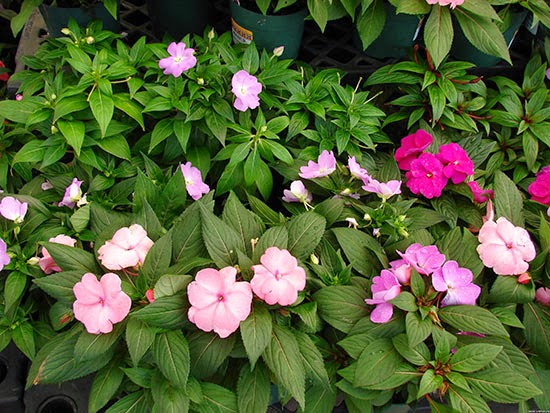 You may be interested in:
You may be interested in:More than 100 different species of this plant are known. Florists distinguish the following varieties:
- Variegate myrtle forms beautiful variegated leaves that are covered at the edges with stripes and dots. To maintain a bright color, this species must be grown in good light conditions. In a comfortable environment, the plant dissolves white compact flowers with a beige tint.
- Myrtle Tarentina is a dwarf plant that is derived from the common myrtle. The flower is characterized by abundant snow-white flowering. Small flowers are collected in small inflorescences. The plant has a pleasant aroma due to the high content of essential oils. Elongated leaves grow to 1.5 cm in length.
- Lemon myrtle is quite common in the tropical climate of Australia. This variety is widely used in cooking, because it has a pronounced smell of lemon. Sauces, drinks, syrups and various seasonings are prepared from leaves. Snow-white flowers are collected in dense inflorescences, which can be seen in the photo.
- Myrtle Communis is represented by a compact evergreen tree. Among the elongated leaves, a large number of snow-white flowers form. In the people, this variety was called "dead tree".
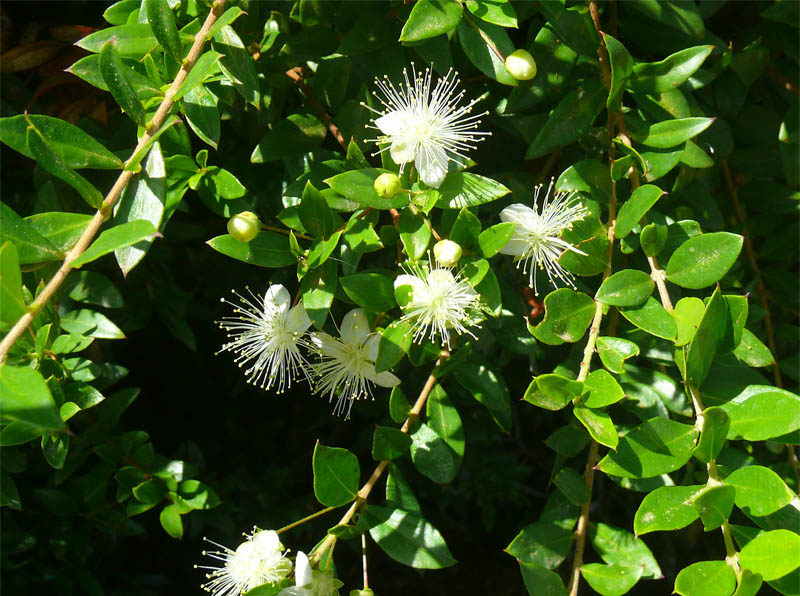
Mirt Communis
Myrtle Care at Home
Like most home flowers, myrtle needs to create certain conditions and the attention of the grower. With proper care at home, the tree will thank you with beautiful and abundant flowering.
Location and lighting
The plant prefers bright lighting, but on hot days it is better to shade it a bit from direct rays.
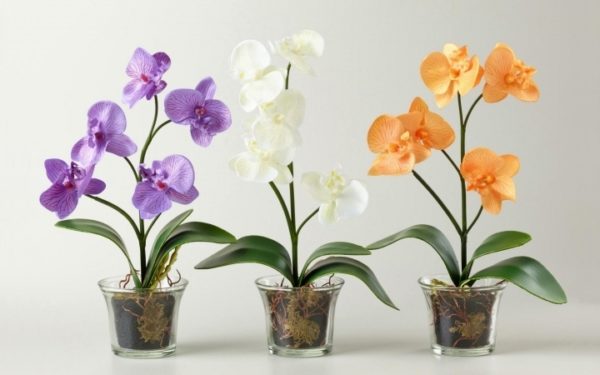 You may be interested in:
You may be interested in:Temperature and humidity
With the onset of spring and before winter frosts, the optimum temperature for growing is 20 ° C. In winter, myrtle need to create cool conditions with an air temperature of about 7 ° C.
A tropical flower needs high humidity. The dry air in the room adversely affects both flowering and general condition. It is recommended to carry out regular spraying of deciduous mass, especially on hot days.
Watering and feeding
In spring and summer, the flower is regularly and abundantly watered with settled water at room temperature. Watering should be after drying of the upper layer of the substrate. In the autumn-winter period, watering is significantly reduced. It is important to constantly monitor the condition of the soil, it should be moderately moist all the time. Do not allow the complete drying of the earthen coma. In addition, it is necessary to avoid stagnation of water in the pot, which contributes to the emergence of diseases.
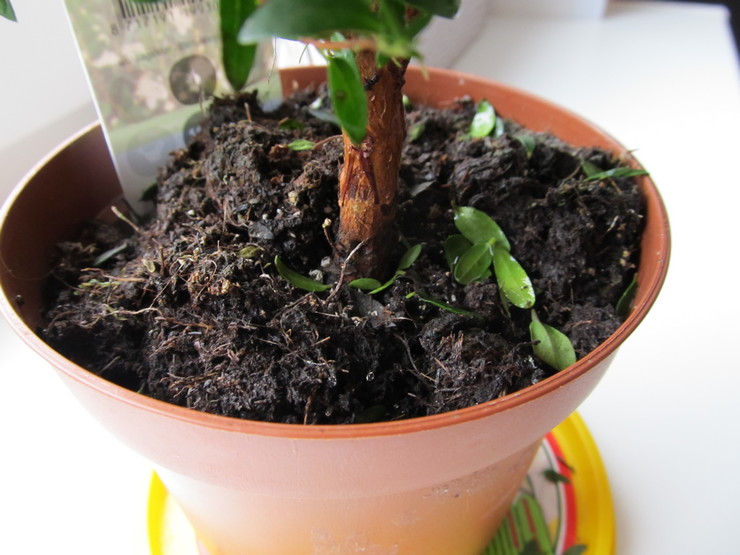
During the growing season, the flower needs weekly dressing, although some gardeners feed it once every two weeks. For abundant flowering, fertilizers with a high phosphorus content are selected. If the compact tree is more to your liking, then they are fed with nitrogen-containing preparations. Beginners are advised to buy complex nutrition in liquid form. It is best to make nutrients the day after watering.
There is a fertilizer created specifically for this species, which is called "Myrtle". It consists of concentrated biohumus and water. The contents of the container are shaken and diluted with water in a ratio of 1: 5. Water the flower abundantly until water appears in the pan.
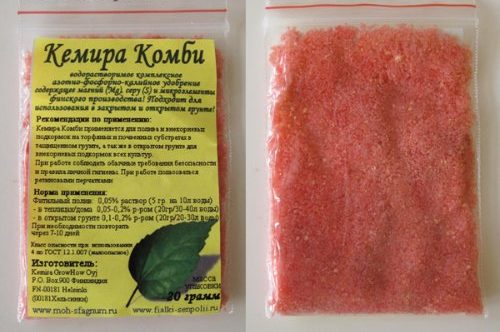
Kemira Combi mineral fertilizer is a pink powder that is easily soluble in water. Top dressing is ideal for a flower, because in its composition there is no calcium, which has a bad effect on development. The following substances are balanced in the fertilizer:
- phosphorus;
- nitrogen;
- magnesium;
- potassium;
- copper;
- sulfur;
- zinc;
- manganese;
- selenium;
- molybdenum.
There is an analogue of this fertilizer - the drug "Fertika", which has the same properties and composition. You can use these solutions twice a month.
Pruning, pinching
Regular pruning contributes to crown formation. Spend this procedure in the spring. Timely pinching as necessary, regardless of the season, increases the density of the crown.
 You may be interested in:
You may be interested in:It is important to pay special attention to shaping trimming. If you do not carry out forming procedures, then the tree is likely to grow in a pyramidal shape. Cutting off the tops gives the plant a bushy appearance. If you cut the sides, you can get a pretty lush tree. Pruning does not affect the flowering period, but it is important to remember that too frequent pinching reduces the number of flowers.
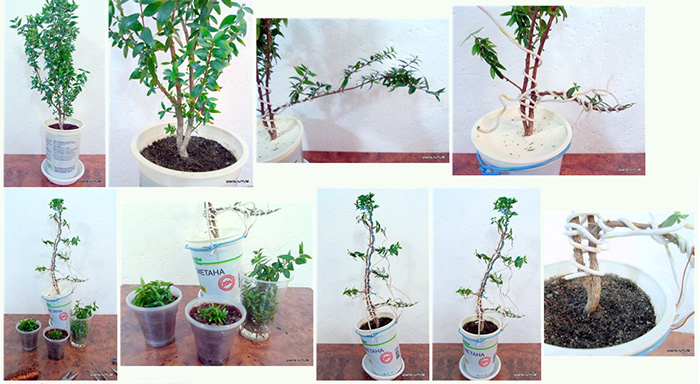
It is better not to prune the young tree, but to pinch a little in order to create the necessary shape. Pruning is carried out only for those plants whose trunk is already quite strong.
Winter season
With the onset of autumn, the plant is preparing for a period of rest. At this time, watering begins to decrease and feeding is gradually eliminated. At rest, watered once a week, if the soil had time to dry.
During rest, the flowerpot is transferred to a cool and bright room, the temperature of which should not exceed 10˚C. If a plant is showered with leaves, this is a sign of fever. But this is not scary, because new foliage will grow with the onset of spring. Spray a flower only if it hibernates in a warm place. Top dressing is excluded or administered once a month.
Diseases and Pests
Diseases and pests often affect the plant with improper care. Dry air and lack of moisture are ideal conditions for the appearance of aphids, scale insects and spider mites.
In the early stages of scabies, it is very difficult to detect insects. The pest multiplies rapidly and covers the aerial part with dark spots. The scabbard is removed with a moistened cotton pad, and the myrtle is treated with the Actellic insecticide.
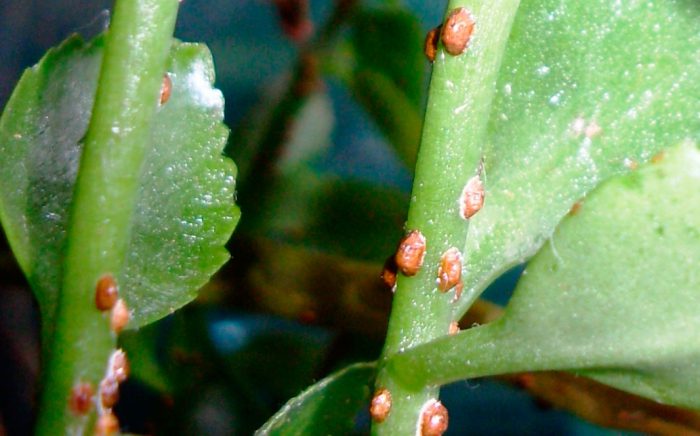
The aphid lives on the bottom of the leaf and sucks the juice from the flower. Weakened leaves curl and dry. To combat it, special insecticidal drugs are used.
A spider mite can also be found in the lower part of the leaves. The pest envelops the place of residence with a thin white spider web. The leafy part is carefully washed with water or a weak tobacco tincture. You can get rid of pests with the help of insecticides.
With proper care, the flower rarely gets sick. Frequent and excessive watering can trigger the development of root rot. The disease can also be in soil that has not been decontaminated before planting. The plant becomes sluggish and lowers the leaves. To combat root rot, you should use the following drugs:
- Maksim. One ampoule of the drug is diluted in 1 liter of water and watered a flower of 100 ml per day. The drug is also suitable for spraying.
- The discourse. To prepare the solution, take 5 g of the active substance and 10 l of water.
- Baikal EM-1. The solution is made up of 1 liter of water and 10 ml of the drug.
When infected, it is necessary to trim the damaged areas, transplant the myrtle into fresh soil and reduce watering.
How to propagate and transplant a flower at home?
Propagated by a tree by cuttings and seed method. Both options are good results and are great for breeding at home.
Seeds
A substrate is prepared for the seeds, which should consist of peat soil and sand in equal proportions. Before sowing, the soil is moistened with a weak solution of fungicide.
Spread the seeds on the soil and sprinkle them with a layer of soil mixture. The container is covered with glass or film. The mini-greenhouse is regularly ventilated and moisturized. The first sprouts appear on the 7-10th day after planting.
After the formation of 2-3 leaves, young seedlings are transplanted into separate containers.
Cuttings
Cuttings occur as follows:
- Cuttings are cut from the side or main shoot, the main thing is that there are no buds on it. The length of the handle should be at least 7 cm.
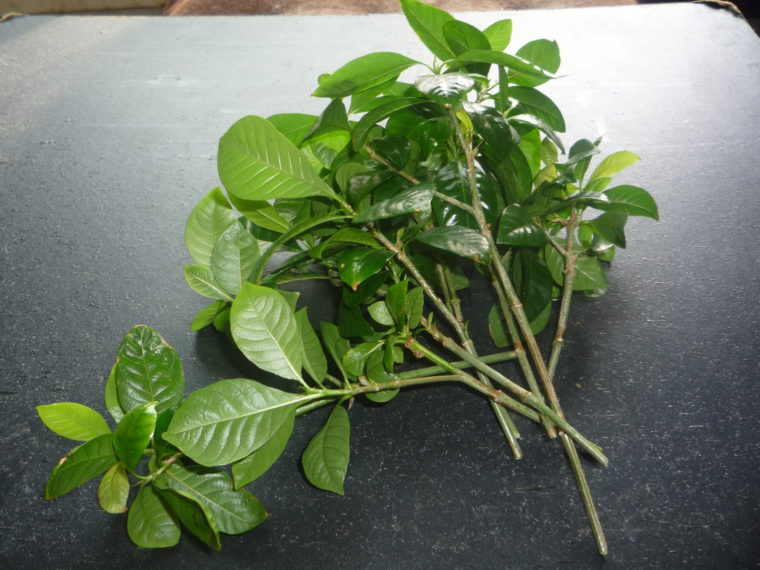
Myrtle Cuttings - Leaves are removed from the bottom of the planting material.
- The upper leaves are trimmed a little.
- Cuttings are treated with "Kornevin" to stimulate the development of the root system and planted in a substrate of coarse sand and leafy soil.
- The container is covered with insulation material and transferred to a cool, shady place.
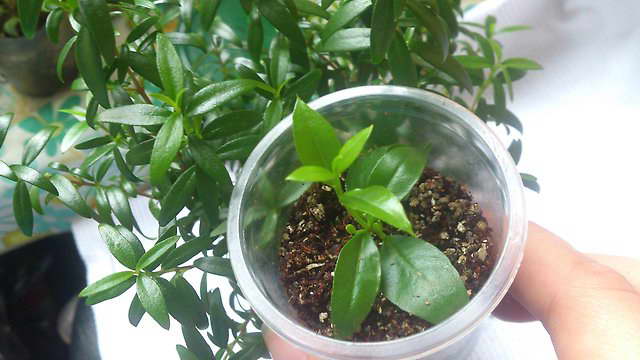
Myrtle propagation by cuttings - Planting material is regularly sprayed and watered, not forgetting to periodically ventilate the greenhouse.
Roots are formed within a month, after which it is possible to transplant the cuttings into separate flowerpots.
Transfer
Myrtle is not a fast-growing houseplant, so it is transplanted once every three years. Do not forget about this procedure, because during the growth the flower took all the nutrients from the soil, and the new soil will positively affect the development. It is best to transplant in the winter.
A few days before transplantation, myrtle ceases to be watered, so that it is easier to extract it from the pot. Carefully remove the tree from the container, holding the trunk.
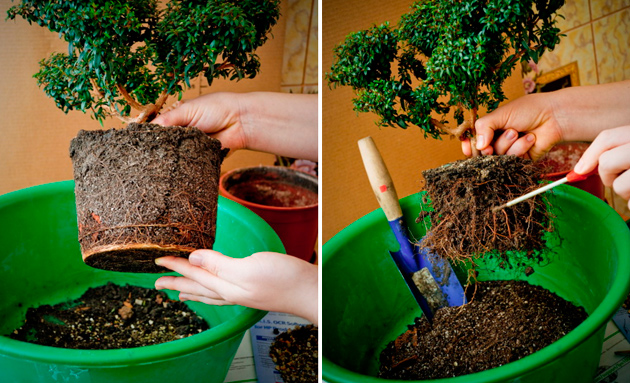
A new flowerpot should be slightly larger than the previous one, because in a too spacious pot the myrtle is unlikely to bloom. The bottom of the pot is filled with a layer of quality drainage. A layer of soil mixture is poured on top, a plant is placed and covered with soil. When landing, you can not bury the trunk in the ground, it must be on the surface. After the procedure, the flower is abundantly watered and shaded for a while.
Useful and harmful properties of myrtle
In addition to decorativeness, myrtle also has healing properties. The essential oils that the aerial part secretes adversely affect bacteria and viruses. The flower has a positive effect on performance, normalizes the functioning of the nervous system and increases resistance to viral diseases.
In folk medicine, this plant is widely used for the preparation of various tinctures, lotions, oils. Myrtle-based medicines treat colds, skin diseases, herpes, tonsillitis, etc.
Common questions
Indoor myrtle will become an unusual decoration of any apartment. But before buying a flower, it is advisable to make sure that there is no allergy to the essential oils that this plant gives off.

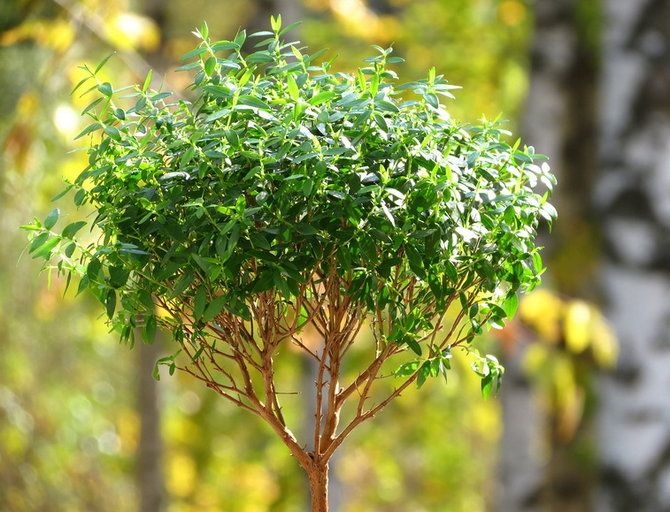

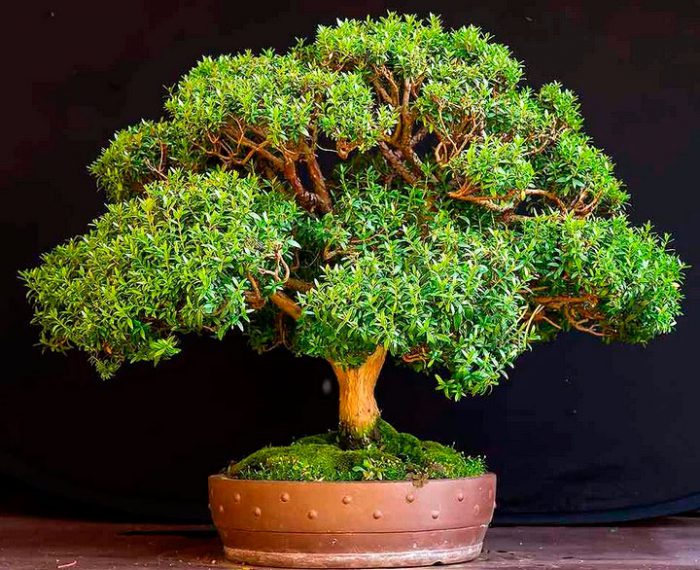
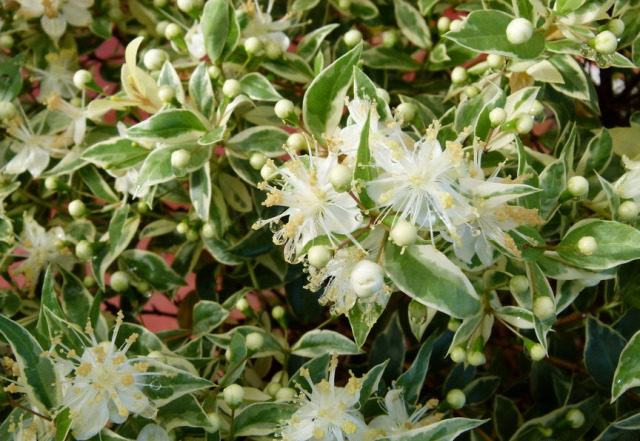
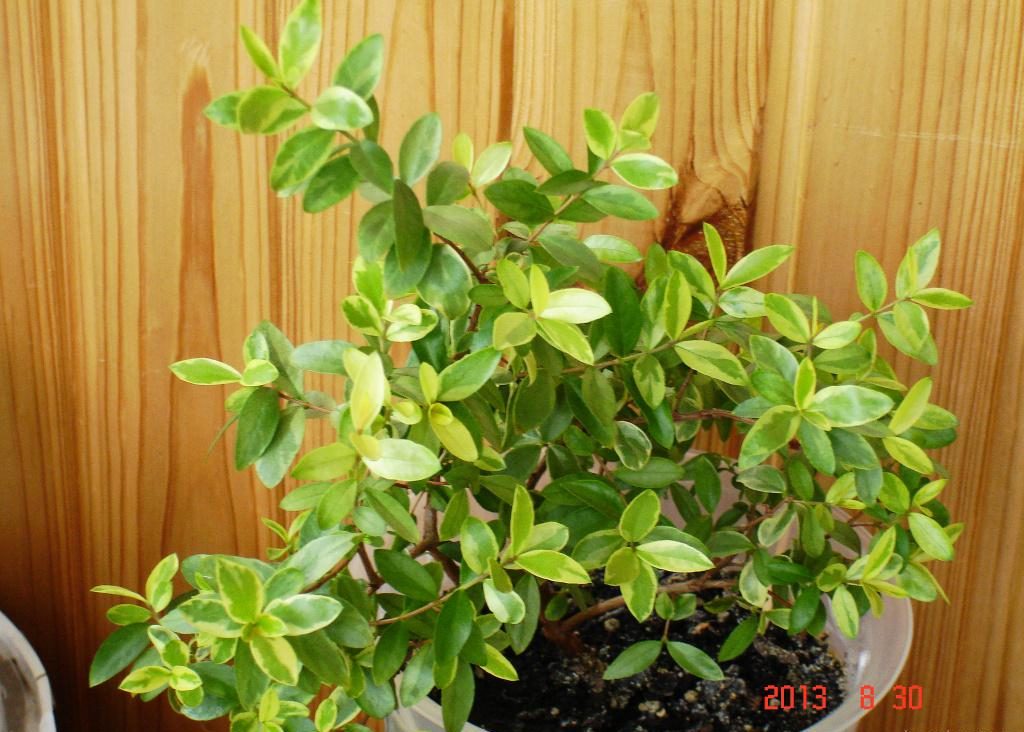
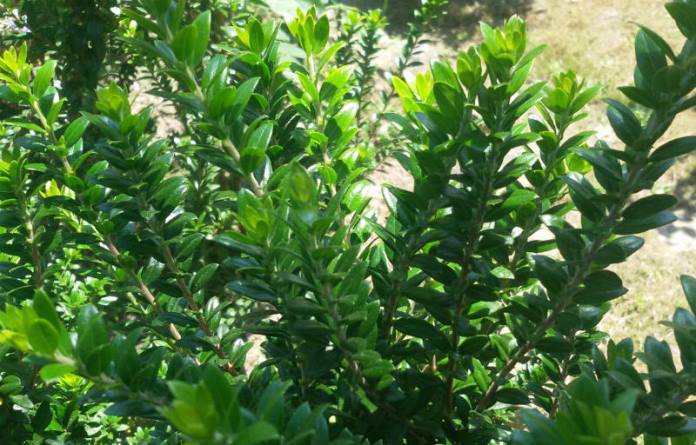
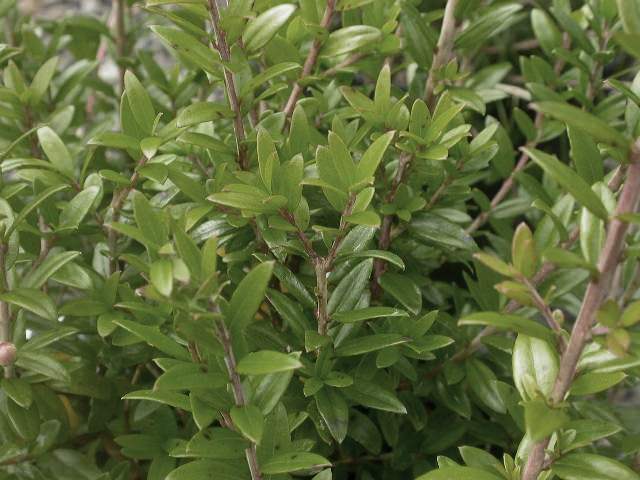
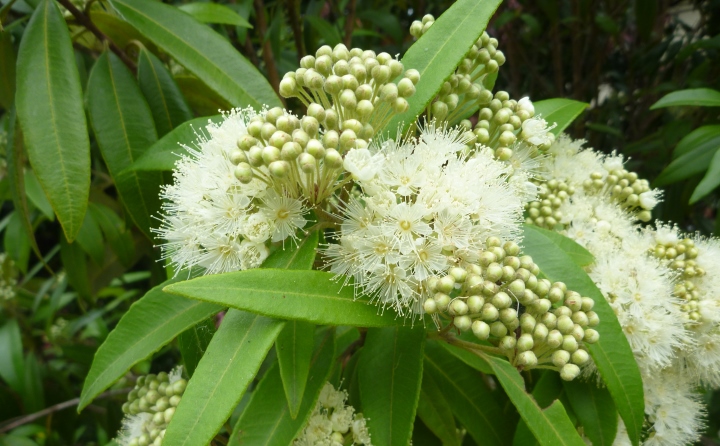
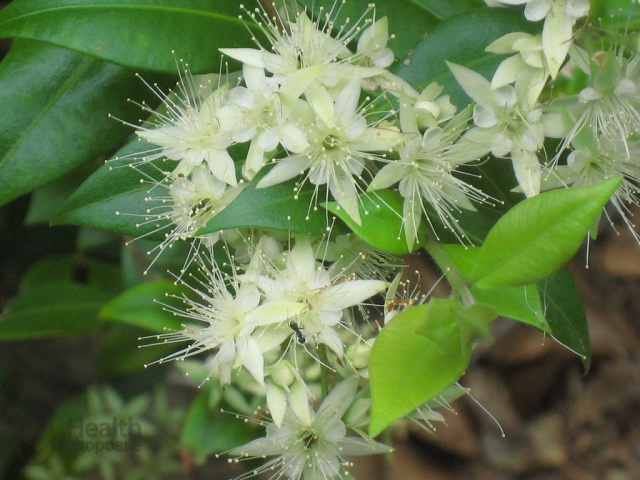



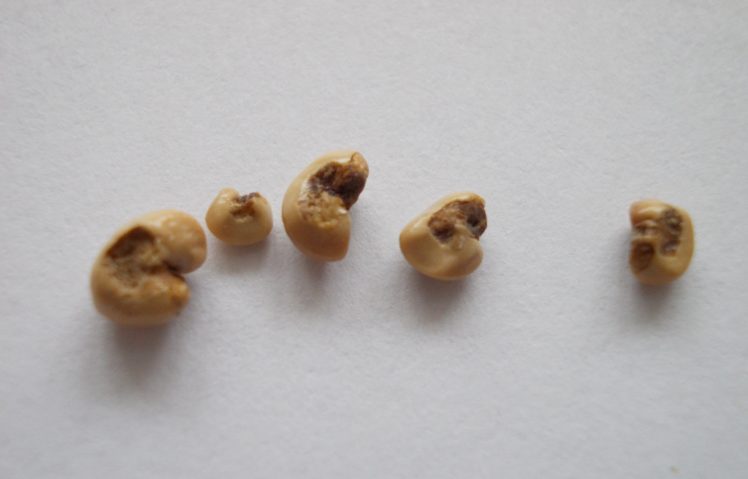
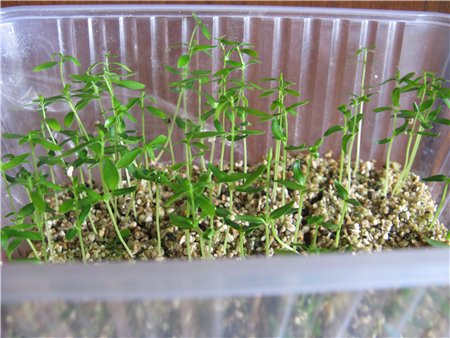
 10 beautiful annuals that bloom all summer
10 beautiful annuals that bloom all summer Sow in the ground, without seedlings: 10 beautiful and unpretentious flowers
Sow in the ground, without seedlings: 10 beautiful and unpretentious flowers Platicodon planting and outdoor care
Platicodon planting and outdoor care Hosta - planting and care in the open ground in the Urals
Hosta - planting and care in the open ground in the Urals